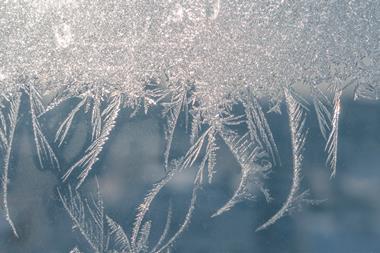Polymer material could protect planes and wind turbines from potentially catastrophic build-ups of ice
When ice forms on jet engines and wind turbine blades it can have deadly consequences, and yet removing ice from such structures can be difficult and costly. Several different designs for ice-resistant coatings have been devised, but some offer only moderate protection or lose their protective qualities after a limited number of cycles of de-icing. Now, researchers in the US have designed a coating based on oil-impregnated polymers that combines durability, mechanical and chemical stability with some of the lowest affinities for ice ever seen.1 Furthermore, they are compatible with standard industrial coating processes, so the researchers believe they will have ‘immediate, worldwide applications across various industrial sectors’.
Materials scientists measure the strength that ice sticks to a surface using the force required to break a given area of ice from the material. A surface that has an ice adhesion strength of less than 100kPa is considered icephobic. Unfortunately, ice sticks very strongly to many structural materials – aluminium, for example, has an ice adhesion strength of 1600kPa.
Researchers have created coatings with ice adhesion strengths as low as 0.4kPa by using lubricants or gels, but these often lose their icephobicity after being de-iced only a few times. Interesting designs have been produced using textured surfaces that trap air, preventing water from freezing in contact with the surface, but these encounter problems if the grooves become clogged with frost. Another icephobic surface works by using the latent heat released by droplets as they freeze to propel them away from the surface, but this only works at well below atmospheric pressure.2 No durable surfaces that maintain an ice adhesion strength less that 15kPa under realistic conditions have been demonstrated.
Breaking the ice
Anish Tuteja and colleagues at the University of Michigan, Ann Arbor and Edwards Air Force Base in California used elastomers – rubbery polymers that exhibit both solid- and liquid-like properties. To reduce the force required to move an ice crystal on a surface, the researchers made the elastomer softer by decreasing the density of polymer cross-links. For example, polydimethylsiloxane (PDMS) with a lot of cross-links has an ice-adhesion strength of over 250kPa, whereas PDMS with fewer cross-links has an adhesion strength of just 33kPa. This, explains Tuteja, arises because ice detaches from an elastomer by a process called interfacial cavitation. ‘There’s a lot of air pockets generated between the hard surface of ice and the underlying rubber,’ he says. ‘The softer you make the rubber the easier these air pockets can be created.’
Next the researchers added an oil into the elastomer to enable uncross-linked chains to slide more freely. Simply adding the oil to the highly cross-linked PDMS lowered the ice adhesion strength from 264kPa to 58kPa. The combination of fewer cross-links and the oil together reduced the adhesion strength of ice to just 6kPa – a value never achieved with any icephobic coating before, despite the surface being dry to the touch.
The researchers then created a library of polymers, demonstrating how reduced cross-link density and increased chain lubricity together led to icephobicity. One polymer had ice adhesion energy of just 0.15kPa, but this was too soft to make a viable coating. Nevertheless, the researchers produced other coatings that combined ice-adhesion energies an order of magnitude lower than state-of-the-art commercial icephobic surfaces with much greater stability under repeated de-icing, abrasion and other environmental tests than these commercial coatings. They are now exploring the underlying polymer physics to find out precisely how much the chains move under the ice crystals, and looking to exploit the materials for commercial purposes.
‘It’s the best piece of work I’ve seen so far on icephobic surfaces,’ says Doris Vollmer of the Max Planck Institute for Polymer Research in Germany. ‘It at least seems to solve a lot of problems one could not solve with other approaches.’ Manoj Chaudhury of Lehigh University in the US, who originally helped develop many of the fracture mechanics of interfacial separation, says: ‘I find it very gratifying that something we did a long time ago has been used in some other field, but they have their own original ideas here too … the physical understanding is very solid and they have experimentally shown how it works.’
References
1 K Golovin et al, Sci. Adv., 2016, 527, 82 (DOI: 10.1126/sciadv.1501496)
2 T M Schutzius et al, Nature, 2015, DOI: 10.1038/nature15738












No comments yet